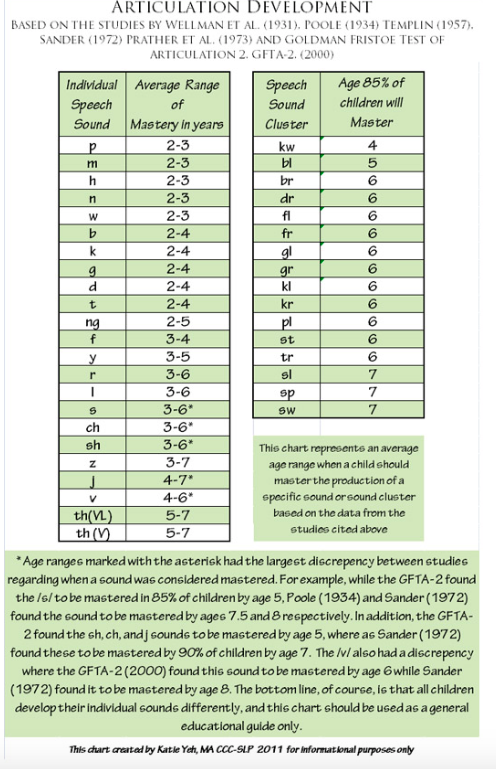
There’s so much information available to parents that it can sometimes be overwhelming, especially when you have concerns about your child. You may hear “children develop on their own time” or children “catch up” without therapy, but what does the research actually say?
Here’s answered to some of the most common questions regarding speech and language in young children.
What is the difference between speech and language development?
Both speech and language are important to communication. A person can have only a speech disorder or a language disorder, or can have both at the same time.
Speech Development
Speech development refers to the sounds used to make words. We use our lips, teeth, jaw, tongue, and voice to produce sounds, like “g” in “dog.” A speech sound disorder, also called an articulation disorder or phonological disorder, is someone that has difficulty producing certain sounds correctly. An example would be saying “dok” instead of “dog.” Young children may say some sounds incorrectly as they learn, but as they get older they are able to start being better understood and say sounds more correctly.
- Children may also stutter (Fluency Disorder), repeating sounds or parts of words.
- Others have difficulty speaking clearly due to an inability to put sounds and syllables together correctly (Childhood Apraxia of Speech), which influences speech production.
Language Development
Language is how we use words to express ourselves. This includes written and spoken language. It involves using grammar, vocabulary, and appropriate word order. There are three types of language disorders:
- Receptive language disorder indicates a person has difficulty understanding parts of language, such as not being able to answer questions correctly, follow directions, or comprehend stories.
- Expressive language disorder refers to a person’s difficulty sharing their thoughts with others, such as not able to request their needs, use vocabulary appropriately, or participate in conversation with their peers.
- Mixed Receptive-Expressive language disorder – A person can have a mixture of both in which they are unable to use or understand language effectively.
What are important milestones for speech and language development?
Milestones and developmental norms are guides for development. While there can be a range of “normal,” we expect all children to follow a typical pattern of development. If you have concerns, please contact a certified speech-language pathologist (SLP).
The biggest indicators for positive speech and language development are consistent growth in:
- vocabulary,
- comprehension,
- sentence length,
- and intelligibility (how much others understand you)
If you see those skills plateau over a 4-6 month period in a child younger than four years old, seek help from a SLP or talk with your pediatrician.
General Speech, Language, Feeding Milestones
Intelligibility Norms
Intelligibility is how much you say is understood by others. This is important as not all young children use speech sounds correctly until they get older; however, we still expect them to be understood by family members most of the time.
| Age | Percentage of Speech Understood by Others |
| 2 years | 50% is understood by others |
| 3 years | 75% is understood by others |
| 4 years | 100% is understood by others |
(Sander, 1972)
Vocabulary Norms
| Age | Number of Typical Words Said | Red Flag |
| 12 months | 2-6 words | No babbling, not trying to say adult-like words |
| 15 months | 10-25 words | Fewer than 10 words |
| 18 months | 50 words | Fewer than 20 words |
| 24 months | 200-300 words + combining two words together “mama go” | Fewer than 50 words and not putting two words together |
(www.childdevelopmentinfo.com)
Articulation
This is a great chart showing the typical range of mastery for each speech sound created by Katie Yeh, a speech-language pathologist. Visit her website to find more information about articulation development and disorders.
What are general red flags I should watch for?
If you see the following, talk with your child’s pediatrician or contact a speech-language pathologist.
- Very little or no eye contact with others
- Unable to request their needs in a way others understand
- Limited words or no words at all by 18-24 months of age
- Little or no interest in communicating with others or using gestures
- Not responding to their name by turning and looking
- Frustration when they are unable to communicate with others or parental concern
If you see some red flags, but you’re still not sure, ask yourself these 4 questions.
Is it true that boys develop speech/language later than girls?
Yes-but just by a few months.
Boys and girls develop language differently, and girls typically develop speech and language faster than boys. However, boys develop speech and language still within the “normal” range of developmental milestones, just a few months later than girls. Boys should still be meeting the general milestones for speech and language. If they are significantly behind their peers, it could be a sign of a language delay or disorder.
It is also true more boys than girls have language difficulties or disorders, a ratio of 2:1 or 3:1. The incidence of Autism is also higher in boys, 4x more common in boys than in girls.
Is it true younger siblings talk later than first-born children?
Not usually.
Research shows language development of first-born and second- or third-born children follow a similar path. One study showed first-born children reach the 50-word milestone earlier, but after that there were no differences between language development in siblings. Although older siblings may interrupt or talk for their younger siblings, it does not appear to have a negative effect on development.
What causes speech/language delays or disorders?
Most of the time, we aren’t sure.
Sometimes a child may have other disorders that contribute to slower development in speech/language, like hearing loss, cleft palate, or a genetic disorder or medical diagnosis such as Autism Spectrum Disorder, Down Syndrome, or other intellectual disabilities. Suspected causes may include genes and heredity (20-40% have family history of speech/language issues), prenatal nutrition, or prematurity.
Approximately 2-8% of school-age children may have a language disorder. Nearly 1 in 12 U.S. children ages 3-17 has had a disorder related to speech, language, voice, or swallowing in the past 12 months (CDC, 2018).
What if my pediatrician said to wait, but I’m still concerned?
Don’t wait! Here’s why!
Pediatricians are often responsible for screening children for speech and language delays at the child’s well check. However, pediatricians have only a general knowledge about speech and language development. Speech-language pathologists are the experts and have more specific education and training to help identify children who need help. Research shows the earlier a child with a delay receives help, the better the outcome will be (Rosetti, 1996).
If you have a concern, contact a certified SLP.
My friend said late talkers always catch up and don’t need therapy. Is this true?
Not true.
Research supports that 70-80% of “late-talkers” will outgrow a language delay if it is an expressive delay only, which only involves spoken language, not understanding or social use of language (Ellis & Thal, 2008). This means 20-30% of young children will NOT catch up to their peers without intervention. When children don’t catch up, they usually have persistent language difficulties that can affect reading and writing as well (Sharma, Purdy & Kelly, 2009). We cannot yet predict which children will catch up on their own, and if we wait it results in later intervention for those that really need help.
Do bilingual children talk later?
No.
Children learning two languages at the same time will follow the same developmental pattern in both of their languages. Sometimes vocabulary may look smaller, but when all words are included from both languages, it should be comparable to their monolingual peers. Bilingual language learners may also mix up words or use different grammar, called “code switching” which is normal and does not indicate the child is delayed. A language difference is NOT a language disorder. A bilingual child with a true language disorder will have deficits present in both languages.
If you have concerns, please contact a bilingual speech-language pathologist.
Here’s the facts of bilingual language development!
How can I help my child develop speech and language skills?
- Talk about things you see, hear, smell, and touch. “I see a squirrel in the tree! I hear an airplane; look in the sky!”
- Expand on your child’s words. For example, if your child says “dog!” you could respond with “Yes, that is a big brown dog!”
- Make time to read together. Point out pictures and talk about what you see on each page.
- Play social games, like peek-a-boo with babies, Ring Around the Rosie with toddlers, or I Spy for older children.
- Use gestures to help you child understand what you mean.
Here’s our full list of go-to strategies to build language!
Where can I find a speech-language pathologist?
ASHA ProFind lets you search certified speech-language pathologists listed by city, state, area of expertise, and bilingual providers. You can also contact your local Early Childhood Intervention (ECI) or school district for more information. Also, we offer free consultation to answer all your questions at Heart & Soul Speech – Contact us today!
Related Articles:
Hearing Loss- What Parents Should Know
Strategies to Help Children Talk
References:
https://www.nidcd.nih.gov/health/statistics/quick-statistics-voice-speech-language
https://www.nidcd.nih.gov/health/speech-and-language
https://www.asha.org/PRPSpecificTopic.aspx?folderid=8589935321§ion=Incidence_and_Prevalence
http://www.hanen.org/helpful-info/articles/fact-or-fiction–the-top-10-assumptions-about-earl.aspx
http://www.hanen.org/helpful-info/articles/a-closer-look-at-the-late-talker-study–why-parent.aspx
Berglund, Eriksson M., and Westerlund M. (2005). Communicative skills in relation to gender, birth order, childcare and socioeconomic status in 18-month-old children. Scandinavian Journal of Psychology, 46, 485-491.
Ellis EM, Thal DJ. (2008) Early language delay and risk for language impairment. Perspect Lang Learn Ed., 15(3): 93-100.
Sharma M., Purdy, S.C. & Kelly, A.S. (2009). Comorbidity of auditory processing, language, and reading disorders. Journal of Speech, Language and Hearing Research, 52(3),706-22.
Rosetti, L.M. (1996). Communication intervention: Birth to three. San Diego: Singular Publishing.


I never knew that boys are two or three times more likely to develop speech/language later than girls! My husband and I have noticed that our son isn’t progressing with his speech as well as he should, whereas our daughter picked up language usage very quickly. Since he’s going to enter kindergarten next year, we should maybe consider finding a good speech therapist in our area to help him.
It’s really interesting how they develop slightly differently, but generally follow the same path for overall language skills. If you have concerns, I would definitely recommend consulting a speech-language pathologist in your area. You are the expert on your child’s needs!